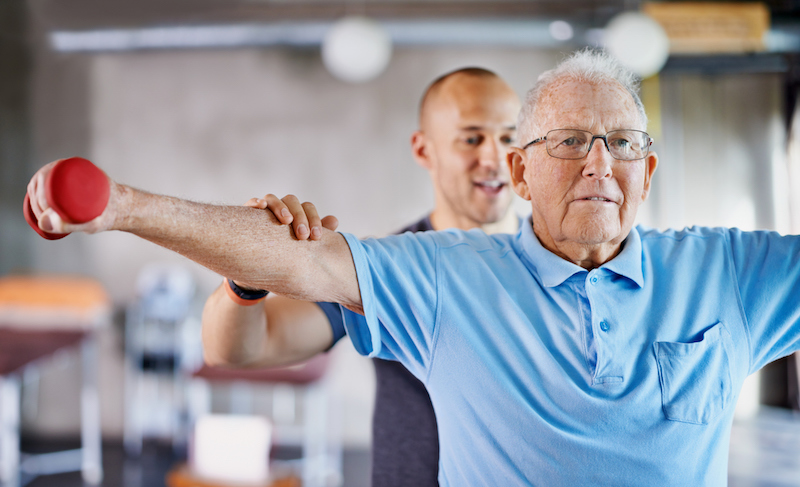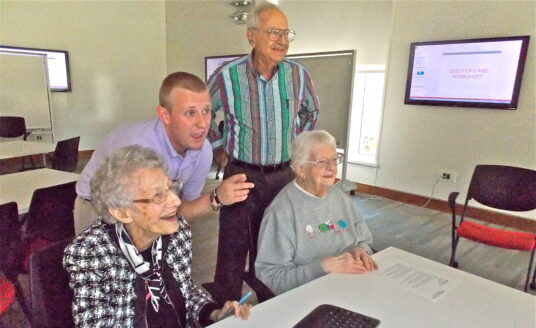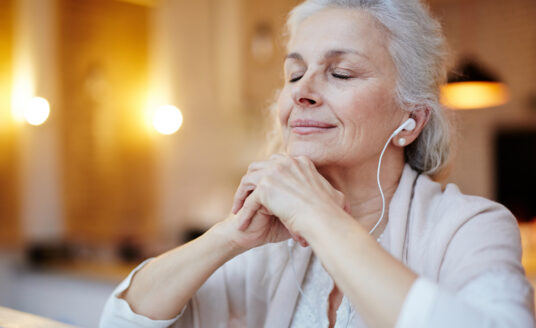Your fitness goals should include your starting point and what you plan to achieve. The combination of these two create focus, reset your priorities, and clearly define what you want to accomplish.
The first step in setting achievable goals is to assess where you are physically. This assessment should be made with the help of your physician to ensure that you reach your goals effectively and safely.
He or she can suggest exercises and activities to participate in and ones to avoid, as well as any tests you might need to take before beginning a program.
How to Start Achieving Your Fitness Goals
You might think that starting an exercise program might be too much for you, particularly if you haven’t exercised in a while. But studies show that many of the changes attributed to aging are actually caused by disuse.
So how do you get started?
Learn About Moderate-Intensity Level Exercise
According to the Centers for Disease Control and Prevention, if you are relatively vibrant and 65 years old and older, you should be able to perform a minimum of at least 150 minutes a week of moderate-intensity exercise like brisk walking, gardening, raking leaves, etc. You can break that up into five days of 30 minutes of exercise, or even two 15-minute sessions per day. Strength training two days a week and balance exercises are also recommended.
The moderate zone heart rate is calculated as 50 to 60 percent higher than your resting pulse, and there are formulas for calculating moderate-activity heart rate. According to the Mayo Clinic, one of the simpler ways is by gauging how you feel. Moderate activity feels somewhat hard. Your breath quickens, but you’re not out of breath. You develop a light sweat after about 10 minutes of activity. You can carry on a conversation, but you can’t sing.
The Mayo Clinic also provides information on this site about calculating moderate-intensity heart rates.
Back off a bit if you are short of breath or in pain, or find that you can’t work out as long as you planned. Be sure to warm up, stretch, and cool down.
Plan Ahead
Write down your fitness goals. You can break this project into a short-term goal list and a long-term goal list.
Short-term goals could involve finding an exercise partner and planning out exercise sessions.
Long-term goals could involve what you want to achieve in 6-12 months. Perhaps the goal involves losing weight, or lowering your blood pressure readings to a healthy range. Perhaps you can set your sights on increasing your walking speed over a given distance, or improving your ability to keep up with your grandchildren. If you have a disability, you might strive to increase your independence and quality of life by building your strength and stamina.
The best goals are the ones that bring you the most satisfaction while improving your health.
Develop an Exercise Routine
Depending upon your specific capabilities, a well-rounded exercise routine incorporates cardiovascular and strength training, as well as stretching and balance exercises. Keep a journal as you advance through your fitness routine, and note any changes and improvements you see or adaptations you make to the routine along the way.
Start Slowly
According to the National Institute on Aging, you should start slowly when beginning an exercise program in order to stay safe and reduce your risk of injury. They recommend the following:
- Begin your exercise program with low-intensity exercises.
- Warm up before exercising and cool down afterward.
- Pay attention to your surroundings when exercising outdoors.
- Drink water before, during, and after your workout session, even if you don’t feel thirsty.
- Wear appropriate fitness clothes and shoes for your activity.
Some of the best exercises recommended for seniors include:
- Swimming
- Chair yoga
- Resistance band workouts
- Pilates
- Walking
- Body-weight workouts
- Dumbbell strength training
Exercises for People with Disabilities
These exercises include isometric exercises (contracting muscles and holding them in the contraction), seated chair exercises, stretching, core strengthening, and other mobility exercises.
There are videos demonstrating chair exercises for older adults.
Despite your disability, you may still be able to walk, use an elliptical machine, ride a stationary bike, or even swim using flotation devices.
Be Consistent
Regardless of the exercise routine you choose, it is important to consistently stay active. Even if you only have a few minutes during a day and can’t complete your entire routine, you should do part of it or find other ways to keep physically moving throughout the day. Better fitness is a life-enhancing goal you can achieve.
| Whether in independent living, assisted living, memory care, or skilled nursing, Bethesda offers the right amenities, services, programming, and staff to make every day full of purpose. See for yourself and tour our independent living communities, including Bethesda Barclay House – Clayton, Bethesda Gardens – Kirkwood, Bethesda Orchard – Webster Groves, Bethesda Terrace – South County, Village North Retirement Community – Florissant, and The Oaks at Bethesda Villas – Kirkwood/Webster. |



